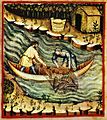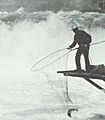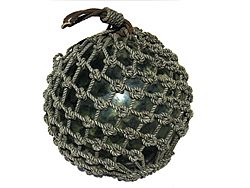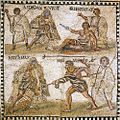Fishing net facts for kids
A fishing net is a special kind of net used to catch fish. These nets are made from strong threads woven together in a grid pattern. Some fishing nets are also called fish traps, like fyke nets.
Most fishing nets are made by tying thin threads together to form a mesh. Long ago, people made nets from natural materials like grasses, flax, and other plant fibers. Later, cotton was used. Today, most nets are made from strong artificial plastics like nylon. However, nets made from natural materials like wool or silk were common until recently and are still used sometimes.
Contents
History of Fishing Nets
Nets from the Past
-
A drawing by Albrecht Dürer from around 1490-1493.
-
Native Americans catching salmon with a loop net in 1938.
People have used fishing nets for thousands of years. They are one of the oldest ways to catch fish. The oldest known fishing net was found in Finland and dates back to about 8300 BC! This shows that early humans were very clever at finding ways to get food.
Over time, fishing nets became more advanced. Different cultures developed their own unique net designs and fishing methods. For example, medieval Scandinavians had special ways to fish through ice. In the 14th century, people in Baghdad used nets, and by the 16th century, detailed drawings showed fishermen using nets and traps in Germany. The famous Chinese fishing nets in India show how large, fixed nets were used to catch many fish.
Different Types of Fishing Nets
There are many different kinds of fishing nets, each designed to catch certain types of fish or to be used in specific places. Here are some common types:
| Type | Image | Description |
|---|---|---|
| Bottom Trawl |  |
This is a very large, cone-shaped net. It is pulled along the bottom of the sea by one or more boats called trawlers. It catches fish that live near the seabed, like cod, squid, and halibut. |
| Cast net |  |
A cast net is a small, round net with weights around its edges. A fisherman throws it by hand so it spreads out on the water and sinks. Fish are caught as the net is pulled back in. It's great for catching small fish that swim in groups. |
| Coracle Net Fishing |  |
This method uses two small, round boats called coracles. Two people, one in each coracle, hold a shared net. When a fish is caught, they pull up their ends of the net until the boats touch, and the fish is secured. |
| Dragnet |  |
This is a general name for any net that is dragged or pulled through a river or along the bottom of a lake or sea. A seine net is an example. You can change how deep it fishes by adding weights. |
| Drift net |  |
A drift net is not tied down; it floats freely with the water current. It is often a gill or tangle net. While used in coastal waters, its use in the open ocean is mostly against the rules. |
| Drive-in Net | This net is used by small-scale fishermen, especially in Japan and the Philippines. It looks like a dustpan with long sides. Fishermen either wait for fish to swim into it or scare them into the net. Then, they close the net to trap the fish. | |
| Fixed Gillnet (on stakes) |  |
These nets are used in shallow areas where the tide goes in and out. They are stretched on poles stuck into the ground, usually in rivers or near the coast, to catch fish as they swim by. |
| Fyke Net |  |
Fyke nets are bag-shaped nets held open by hoops. They can be linked together in long lines and are often used to catch eels in rivers. They can also be used in lakes with lots of plants. |
| Gillnet |  |
Gillnets catch fish by their gills. Fish try to swim through the net but get stuck. These nets use floats at the top and weights at the bottom to stay upright in the water. They are used for fish like sardines, salmon, and cod. |
| Ghost net |  |
Ghost nets are fishing nets that have been lost or left in the ocean. They can keep catching marine animals for many years, which is very harmful to ocean life. |
| Hand net | 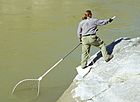 |
Hand nets, also called scoop or dip nets, are held open by a hoop and have a short or long handle. They are used to scoop up fish near the water's surface. When used by an angler to help land a fish, it's called a landing net. |
| Landing Net |  |
Landing nets are large nets held by hand. They are used by anglers (people who fish with a rod and line) to safely lift large fish, like common carp, out of the water once they've been caught. |
| Lave net | 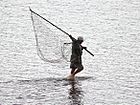 |
A special type of large hand net used in a few places on the River Severn in England and Wales. The fisherman holds the net in the water and waits to feel a fish hit the mesh, then lifts the net. Even large fish like sturgeon can be caught this way. |
| Lift net | 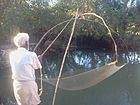 |
A lift net has an opening that faces upwards. It is lowered into the water and then quickly lifted out. It can be lifted by hand or by machines, and can be used from a boat or from the shore. |
| Midwater Trawl | This cone-shaped net is pulled through the middle of the water, not on the bottom. It catches fish that swim in open water, like anchovies, shrimp, tuna, and mackerel. One or two boats can pull it. | |
| Plankton net |  |
These nets have a very fine mesh and are used by research vessels to collect tiny organisms called plankton from the ocean. Scientists use them to study ocean life. |
| Purse seine |  |
This net is widely used by commercial fishermen. It's a large net that surrounds a whole group of fish. The bottom of the net can then be closed, like pulling the drawstring on a purse, to trap the fish completely. |
| Push Net |  |
A small, triangular net with a strong frame. It is pushed along the bottom in shallow water to catch shrimps and small fish that live on the seabed. |
| Seine net | 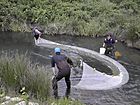 |
A large fishing net that can be used in different ways. In purse seine fishing, the net hangs straight down in the water with weights at the bottom and floats at the top. A common way to use it is as a beach seine, where the net is pulled from the shore. |
| Shore-operated Lift Net |  |
These huge nets are held out horizontally by large structures on the shore. They are lowered into the water and then raised again. They can't be moved around. The most famous ones are the Chinese fishing nets in Kochi, India. |
| Surrounding net |  |
This net surrounds fish on all sides. It's an advanced type of seine net and is usually used by large fishing boats. |
| Tangle net |  |
Tangle nets are like gillnets but have a smaller mesh. They are designed to catch fish by their teeth or upper jaw bone, rather than their gills. |
| Trammel | A trammel net has three layers of netting. The middle layer has a small mesh and is loose, while the two outer layers have a much larger mesh and are tight. Fish get tangled in the loose middle net. Floats keep it upright. |
Fishing Lines
Ropes and lines are made from long fibers twisted or braided together. They are very strong and are used for pulling. Good ropes and lines have been very important for making fishing nets bigger and better.
Floats for Nets
Some fishing nets, like seine and trammel nets, need to hang straight up and down in the water. To do this, they use floats at the top. In the past, people used light woods like cork for floats. Today, floats are often made of bright plastic foam so they are easy to see.
- Small floats were often made from cork. In places where cork wasn't available, people used other materials like birch bark or special roots from mangrove trees. Now, most small floats are made of plastic foam.
- Glass floats were large glass balls used for long nets in the ocean. Now, strong plastic floats have replaced them. These floats help keep nets, droplines, and longlines floating. Larger floats often have flags to make them easier to spot.
- Old glass floats are popular items for collectors today.
Weights and Anchors
To keep the bottom of a fishing net down in the water, weights are used. Long ago, a culture called the Cucuteni-Trypillian culture (around 5500 BC to 2750 BC) made ceramic weights in different shapes and sizes. These were used for weaving cloth and also for fishing nets.
Even today, some fishermen use natural items like dog conch shells as weights for their nets.
Other Ways to Catch Fish
Besides nets, people also use other methods to catch fish:
- Spears
- Tame cormorants (birds trained to catch fish)
Images for kids
-
A retiarius (a type of Roman gladiator who fought with a trident and a cast net) fighting another gladiator in a mosaic from the 4th century BC.
-
Ceramic weights from the Cucuteni–Trypillia culture.
-
A special tool called a net cutter, used by scuba divers.
-
A Loggerhead sea turtle swimming out of a fishing net through a turtle excluder device.
See also
 In Spanish: Red de pesca para niños
In Spanish: Red de pesca para niños



